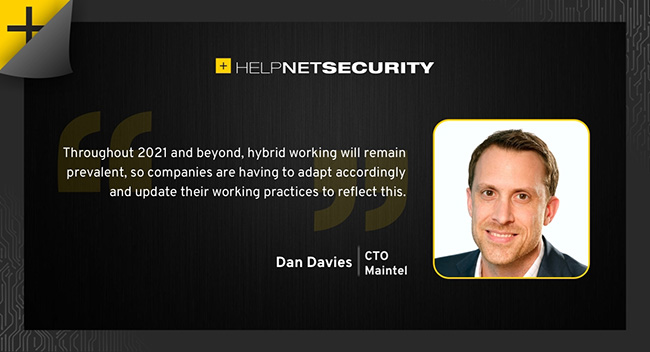In 2020, the pandemic was a radical turning point in the way we work. Office workers were forced to give up their commute and work from home. People from a whole range of industry sectors had to embrace technology, video conferencing and new communication tools within a very short space of time. This year, companies are having to accept that things have yet to return back to “normal” and that remote working and hybrid working is here to stay for the foreseeable future.

According to research from Gartner, 47% of company leaders plan to allow employees to continue to work remotely all of the time. This marks a complete change in attitudes towards flexible working and makes one of the major concerns of many CTOs how to maintain a productive workforce outside of the traditional office environment. More importantly, they are concerned about keeping their staff – who are likely to be split between both the office and home – safe from cyber-attacks and reliably connected.
Learning from the remote working rush in 2020
As countries across the world were plunged into lockdown last year, many businesses scrambled to put solutions in place so that staff could continue to work from home. At first, businesses were simply making do – having staff working and productive was the goal. For some, this meant rushing out consumer-grade tools and neglecting IT security best practice to simply keep the lights on. As a result, one-in-five UK workers have received no cyber training.
Hackers are looking to exploit this, and the risk factor could be even more apparent in the world of hybrid working, with CTOs and CISOs having to find ways of delivering corporate level protection across multiple business and office locations, with data and applications increasingly being delivered from multiple public cloud services.
Some decision makers may be worried that having too many layers of security and too many passwords or authentication processes for employees could hamper productivity. CTOs, therefore, need to take the lessons learnt from last year and take steps to ensure that the hybrid workforce of the future is both secure and productive at the same time.
Security and data protection
Cybersecurity for the hybrid workforce will be central to most companies’ IT strategy in the coming years as CTOs look to improve network architecture, cloud and videoconferencing technology. There will also be a focus on business continuity going forward, enabling companies to seamlessly and safely switch between various ways of working.
And, as data is one of the most important assets of a company, protecting it becomes even more important when the workforce is split between corporate offices and remote home offices.
Making sure employees use good quality and secure Wi-Fi connections is a good starting point. This is also essential for contact center workers in order to ensure the quality of the calls and that the sound is clear and uninterrupted.
Providing staff with enterprise grade laptops, and ensuring they are using safe and secure applications – rather than turning to consumer tools – will also be a key consideration going forward.
Meanwhile, training existing and new staff on best practices is the best way to make sure that the core IT networks aren’t exposed to threats and that organizations don’t experience loss of data due to negligence or user naivety.
Aside from protecting company offices, CTOs will have to learn to do the same for hundreds (or perhaps thousands) of “home offices” when hybrid working is in place. Therefore, business leaders should have in mind that however secure we believe our home environments to be, they were never designed to ensure the availability and protection of sensitive data.
Losing customer or corporate data is more than an inconvenience, it can have a dramatic impact on reputation and competitiveness. Securing the connection, protecting the end-points and encrypting application data is, therefore, every bit as important in the home as it is in the office.
Giving staff the right tools
Most business leaders have now seen the potential benefits of staff working from home. However, there are hidden factors that undermine an employee’s ability to effectively work remotely. Whether it’s working from a small screen laptop, extraneous noise, or competing for the internet bandwidth with family members, there are a number of potential challenges to overcome.
CTOs should therefore consider whether staff have enterprise level equipment, such as headsets, printers, or collaboration tools. If not, they should take steps to ensure their workers have the right equipment to be as productive as possible. The aim should be to provide staff with the same level of tools and protection, regardless of location.
Businesses should also consider leveraging secure SD-WAN connectivity, so that business traffic can be prioritized over a network, ensuring that staff have enough bandwidth to complete tasks at hand.
Conclusion
Throughout 2021 and beyond, hybrid working will remain prevalent, so companies are having to adapt accordingly and update their working practices to reflect this. Despite the economic downturn, there are plenty of opportunities for businesses to thrive if they provide the right equipment, technology and support for staff, so that they can become a more productive and motivated workforce in the long run.
2020 was simply about getting the remote worker working, 2021 will be about industrializing the hybrid workforce.
from Help Net Security https://ift.tt/2NAAjc3




0 comments:
Post a Comment